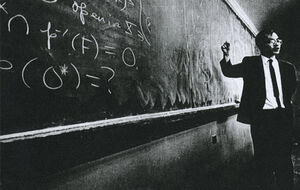Hing Tong (nonfiction): Difference between revisions
(Created page with "[[|thumb|Hing Tong.]]'''Hing Tong''' (16 February 1922 – 4 March 2007) was a leading American mathematician. He is well known for providing the original proof of the Katetov...") |
|||
| (2 intermediate revisions by the same user not shown) | |||
| Line 1: | Line 1: | ||
[[|thumb|Hing Tong.]]'''Hing Tong''' (16 February 1922 – 4 March 2007) was a leading American mathematician. He is well known for providing the original proof of the Katetov–Tong insertion theorem. | [[File:Hing Tong.jpg|thumb|Hing Tong.]]'''Hing Tong''' (16 February 1922 – 4 March 2007) was a leading American [[Mathematician (nonfiction)|mathematician]]. He is well known for providing the original proof of the Katetov–Tong insertion theorem. | ||
Hing Tong was born in Canton, China. He received his bachelor's degree from the University of Pennsylvania. In 1947, he received his doctorate in mathematics from Columbia University, where his thesis advisor was | Hing Tong was born in Canton, China. He received his bachelor's degree from the University of Pennsylvania. In 1947, he received his doctorate in mathematics from Columbia University, where his thesis advisor was Edgar Lorch. In 1956, he married fellow [[Mathematician (nonfiction)|mathematician]], Mary Powderly. He was the father of five children. | ||
Hing Tong made many significant contributions to the area of algebraic topology, and served in a number of academic capacities. In 1947, after receiving a National Research Council fellowship, he became an assistant professor at Barnard College (Columbia University). In 1955, he was a visiting scholar at the Institute for Advanced Study in Princeton. Also in 1955, he was appointed professor of mathematics (and eventually chairman of the mathematics department) at Wesleyan University. He later became a professor of mathematics at Fordham University, where he also served as chairman of the department. He was listed among the Outstanding Educators of America in 1973. Tong retired from academia in 1984 to concentrate on research in theoretical physics. A commemorative brick in the [[Paul Halmos (nonfiction)|Paul Halmos]] Commemorative Walk at the Carriage House Conference Center of the Mathematical Association of America (MAA) in Washington, DC, reads: "Hing Tong, Topology and Physics". | Hing Tong made many significant contributions to the area of algebraic topology, and served in a number of academic capacities. In 1947, after receiving a National Research Council fellowship, he became an assistant professor at Barnard College (Columbia University). In 1955, he was a visiting scholar at the Institute for Advanced Study in Princeton. Also in 1955, he was appointed professor of mathematics (and eventually chairman of the mathematics department) at Wesleyan University. He later became a professor of mathematics at Fordham University, where he also served as chairman of the department. He was listed among the Outstanding Educators of America in 1973. Tong retired from academia in 1984 to concentrate on research in theoretical physics. A commemorative brick in the [[Paul Halmos (nonfiction)|Paul Halmos]] Commemorative Walk at the Carriage House Conference Center of the Mathematical Association of America (MAA) in Washington, DC, reads: "Hing Tong, Topology and Physics". | ||
| Line 14: | Line 14: | ||
* [[Crimes against mathematical constants]] | * [[Crimes against mathematical constants]] | ||
* [[Gnomon algorithm]] | * [[Gnomon algorithm]] | ||
* [[Gnomon Chronicles]] | |||
* [[Mathematician]] | * [[Mathematician]] | ||
* [[Mathematics]] | * [[Mathematics]] | ||
Latest revision as of 12:50, 8 September 2018
Hing Tong (16 February 1922 – 4 March 2007) was a leading American mathematician. He is well known for providing the original proof of the Katetov–Tong insertion theorem.
Hing Tong was born in Canton, China. He received his bachelor's degree from the University of Pennsylvania. In 1947, he received his doctorate in mathematics from Columbia University, where his thesis advisor was Edgar Lorch. In 1956, he married fellow mathematician, Mary Powderly. He was the father of five children.
Hing Tong made many significant contributions to the area of algebraic topology, and served in a number of academic capacities. In 1947, after receiving a National Research Council fellowship, he became an assistant professor at Barnard College (Columbia University). In 1955, he was a visiting scholar at the Institute for Advanced Study in Princeton. Also in 1955, he was appointed professor of mathematics (and eventually chairman of the mathematics department) at Wesleyan University. He later became a professor of mathematics at Fordham University, where he also served as chairman of the department. He was listed among the Outstanding Educators of America in 1973. Tong retired from academia in 1984 to concentrate on research in theoretical physics. A commemorative brick in the Paul Halmos Commemorative Walk at the Carriage House Conference Center of the Mathematical Association of America (MAA) in Washington, DC, reads: "Hing Tong, Topology and Physics".
In the News
Fiction cross-reference
Nonfiction cross-reference
External links:
- J. Carson Mark @ Wikipedia
